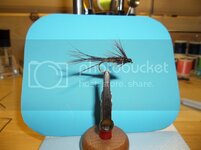redman
New member
Here is a story that is true although he has the pattern a little off. The pattern shown is almost a black knat. The tail was two groups of black bucktail divided for legs then the extra bucktail was brought forward to the eye of the hook with peacock herl tied over it. The bucktail was then tie back over the body and a soft black hen hackle tied as a collar tied back.
http://m.siouxcityjournal.com/sport...50fb-a4bf-6bf0ec9bdcb5.html?mobile_touch=true
Cap and I tied four dozen of these for one of his customers one Saturday afternoon. Larry got it shortly thereafter. I got three of the ones that Cap tied and put them in a fly box of his that I donated to the Iowa Maritime Museum in Arnolds Park, Iowa. When you tie 24 of the same pattern at the hand of the master and originator of the pattern you don't forget.
True story as Cap told me he was going to show Larry the pattern. I have tied that pattern for the last thirty odd years and it will slap kill bluegill and bream when they are feeding on crickets. Mostly a early fall pattern in Iowa and would be a summer pattern in the southland. Crickets down in this part of the world tend to have more grayish brown color. The crickets up in Iowa were more black. Still to this day if I want to catch bream or bluegill I will fish a Cap's woolie jig black body with a grizzly hackle wrap on a 1/100 oz. Jig head.
Redman
http://m.siouxcityjournal.com/sport...50fb-a4bf-6bf0ec9bdcb5.html?mobile_touch=true
Cap and I tied four dozen of these for one of his customers one Saturday afternoon. Larry got it shortly thereafter. I got three of the ones that Cap tied and put them in a fly box of his that I donated to the Iowa Maritime Museum in Arnolds Park, Iowa. When you tie 24 of the same pattern at the hand of the master and originator of the pattern you don't forget.
True story as Cap told me he was going to show Larry the pattern. I have tied that pattern for the last thirty odd years and it will slap kill bluegill and bream when they are feeding on crickets. Mostly a early fall pattern in Iowa and would be a summer pattern in the southland. Crickets down in this part of the world tend to have more grayish brown color. The crickets up in Iowa were more black. Still to this day if I want to catch bream or bluegill I will fish a Cap's woolie jig black body with a grizzly hackle wrap on a 1/100 oz. Jig head.
Redman


